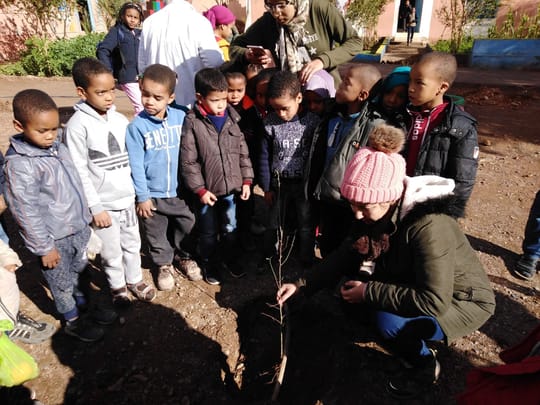Climate Change Sensitisation and Adaptation: Planning in Zagora

By Kerstin Opfer
Operations Manager
North Africa is one of the world’s most vulnerable regions to climate change and characterised by severe environmental degradation. This compromises already scarce natural resources and thereby the countries’ economic performance, which is heavily dependent on natural capital such as agriculture, phosphates, mineral resources and fisheries. This in turn also entails consequences for human development: While absolute poverty in North Africa has decreased, populations remain vulnerable to poverty, a situation complicated by environmental degradation, climate change and the overexploitation of natural resources.

Morocco is no exception. Creeping desertification, compromised forest areas, diminishing water resource potential, the sharp degradation of fragile ecosystems like oases and the coast, and high vulnerability to climate change and natural disasters is not only threatening Morocco’s rich biodiversity but also the livelihoods, well-being and health of many Moroccans. This is particularly apparent in the Zagora Province in southeastern Morocco. The region is characterized by hot and dry desert climate, so water supply is low to begin with but growing demands from unsustainable agricultural methods and climate change have pushed the area into extreme stress. Desertification is a harsh reality in this region. Salt concentrations in the water are so high that the water becomes undrinkable and due to long-lasting droughts palm and fruit trees are dying, leaving farmers without livelihoods.

In this context, the High Atlas Foundation together with a group of highly motivated Peace Corps Volunteers from the Zagora Province distributed and planted 370 almond, pomegranate, and fig trees with three primary schools, two student dormitories and three farmer associations involving 307 people while discussing the importance of trees in mitigating environmental degradation with the children. The children learned that planting trees has many benefits. Trees protect the environment through stabilising the soil and preventing floods, they provide shade and shelter for animals and humans alike, they clean the air and thereby combat climate change, and they increase farmer’s income through the sale of tree products.

Additionally, the High Atlas Foundation conducted four participatory climate change workshops with farmers and women involving a total of 100 people. During these workshops women, men, and youth discussed changes to the oasis farms over the years, learned the science behind climate change, and identified solutions they can champion as local community to preserve the environment and mitigate and adapt to the changing climate. Across all four workshops, community members identified the necessity to sensitise communities about human-made climate change as key priority as well as investing in renewable energy alternatives for producing electricity, pumping water, and cooking, introducing measures to prevent trash burning, and receiving support from the local government to realise those priorities.

Another key priority was to plant well adapted trees that can deal with the frequent droughts and high salt concentrations of the soil and water. As an example for such a well adapted tree, one community member told the success story of a farmer in Zagora, who planted moringa trees and was able to increase his income from the 230.000 MAD he earned from the sale of palm tree products to 6 million MAD through selling moringa tree products. Also called acacia or the drumstick tree, the moringa plant can be irrigated with water containing up to eight grams of salt per liter, and adapt well to desert conditions by drawing water from up to 200 feet under the ground. The plant also protects other crops by creating a barrier from the wind and sand, improves soil quality thanks to its nitrogen-fixing properties which help to revive the soil, and increases farmer’s income through the sale of the variety of by-products of the moringa tree. By-products, for example, are gum arabic, which is used in the food industry as a stabilizer and as a binder in watercolor paints and ceramic glazes, moringa oil, which is extracted from the seeds of the plant and is used in food and medicinal products, and the leaves of the plant, which can be used for nutritional supplements, herbal tea, or mixed with honey. Due to the many benefits of this tree and the success story from the farmer in Zagora, the associations decided to investigate, how they could get hold of moringa tree saplings.

All in all the workshops and tree planting events in the Tamezmoute commune were a huge success. The High Atlas Foundation sincerely thanks the local community members, Peace Corps Volunteers, and local authorities for their hospitality during those exciting and inspiring few days in the Zagora province.